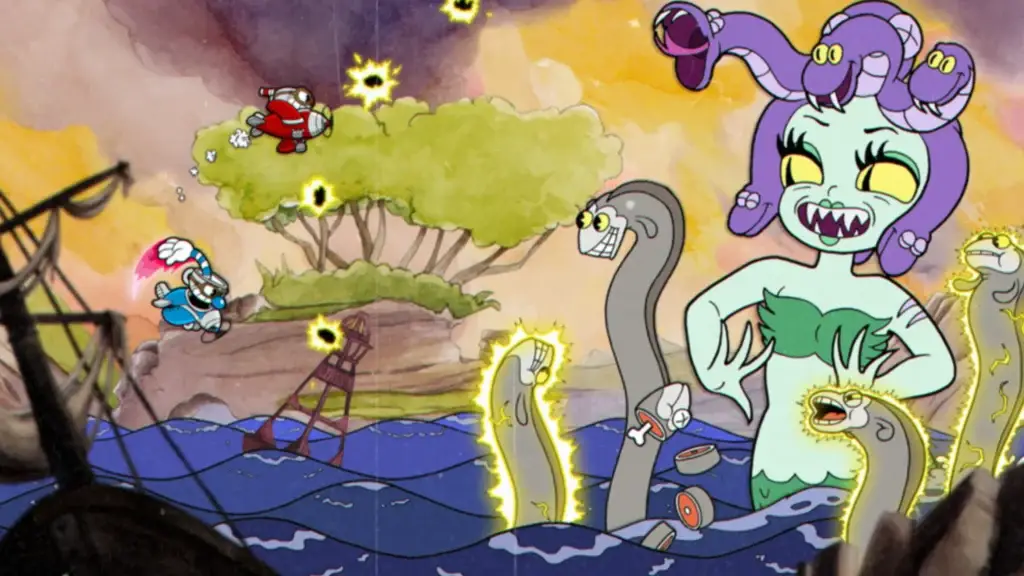In a world where modern projects increasingly rely on realism and complex mechanics, Cuphead has emerged as a breath of fresh air. This vintage platformer instantly captured the hearts of millions, taking users back to the era of classic cartoons. A visual style inspired by 1930s animation, unique hand-drawn graphics and genuine difficulty – an unforgettable adventure for anyone who was thirsty for something new and original.
Why is Cuphead a cult retro platformer?
Cuphead is a true art form, enclosed in a video game form. Each level and character is carefully drawn by hand, which gives the project a unique individuality. Like old cartoons, Cuphead evokes a sense of nostalgia. Fighting bosses, the player finds himself in a bright world filled with a frantic rhythm and incredible challenges. The concept has become an integral part of modern culture: it is discussed, it is copied, it is used as a reference. This is a return to the roots, when every victory required skill and concentration, and losses were an important part of the gameplay.

Cuphead characters – who are they?
The scenario is filled with colorful characters, each of whom brings their own special atmosphere to the process:
- Cuphea is the main character and the face of the game. He likes to take risks and often gets into trouble because of his thirst for adventure. Cuphead has the ability to shoot magic charges from his fingers and dodge enemy attacks. His optimism and fearlessness make him a strong ally and a reliable hero.
- Mugman is Cuphead’s loyal brother and his partner in adventures. In co-op mode, the player can take control of Mugman to help Cuphead. Unlike his brother, Mugman is more cautious and prudent, but this does not prevent him from actively fighting enemies. He also uses magical attacks and has a similar fighting style to Cuphead, but his character brings more humor and comedy to the story.
- King Dice is the Devil’s main assistant and the main antagonist of the game. He runs the casino and acts as a mediator between the heroes and their debts to the Devil. King Dice is extremely cunning and deceitful. His abilities include manipulating various dice and cards, making him a formidable opponent in the final levels of the game.
- The Devil is the main villain of Cuphead. He owns the casino and makes contracts with the characters, promising them wealth in exchange for their souls. When Cuphead and Mugman lose to him, they begin a great adventure to regain their freedom. The Devil has many forms and attacks, which makes the final battle with him especially challenging and exciting.
- Elder Kettle is an elder who acts as a mentor to Cuphead and Mugman. He teaches the brothers the basics of management and combat skills at the beginning of the game. Kettle has wisdom and experience that helps the heroes cope with their tasks. He also provides players with useful advice and reminds them to be careful. Cala
- Maria is one of the most memorable bosses. She is a mermaid inspired by classic cartoon characters who attacks Cuphead and Mugman in a sea location. She can turn into stone, summon electric eels, and use a variety of magical attacks. Cala Maria is a symbol of the difficulty and epicness that sets Cuphead apart from other platformers.
- Baroness Von Bon Bon is the ruler of the Candy Kingdom. Her battle takes place against the backdrop of a huge candy castle, and she uses various sweets in battle that attack the player. She is incredibly emotional and easily upset, which makes the fight with her very chaotic and unpredictable.
- Grim Matchstick is a fire-breathing dragon who lives in the clouds. His attacks include shooting fireballs and summoning small fire creatures. Grim is a reference to the classic dragons from old cartoons, and his fight is one of the most difficult in the game, requiring the player to react quickly and move precisely.
The History of Cuphead — From Idea to Cultural Phenomenon
 The creation of Cuphead began with the dream of two brothers, Chad and Jared Moldenauer. They wanted to create a project that would look and feel like a classic 1930s cartoon. To realize this dream, the developers decided to take radical measures: they mortgaged their houses to get enough funds for work. This desire for perfection paid off — hand-drawn graphics became the hallmark of the concept, attracting both gamers and animation lovers. Each character and background was created by hand, frame by frame, which became a real challenge for a small team.
The creation of Cuphead began with the dream of two brothers, Chad and Jared Moldenauer. They wanted to create a project that would look and feel like a classic 1930s cartoon. To realize this dream, the developers decided to take radical measures: they mortgaged their houses to get enough funds for work. This desire for perfection paid off — hand-drawn graphics became the hallmark of the concept, attracting both gamers and animation lovers. Each character and background was created by hand, frame by frame, which became a real challenge for a small team.
Boss fights and gameplay: a test of nerves
Boss battles are a test of endurance. Each boss fight in Cuphead is a unique test, requiring knowledge of patterns and reaction speed. There is no place for chance: every move and attack must be carefully calculated. The rune and gun format adds dynamics: users must not only attack, but also avoid numerous threats. Boss fights like the Devil, Captain Brinjbord, and more offer a variety of mechanics and force you to adapt to the enemy’s individual style.
Incredible Soundtrack: Sound that Brings You to Life
One of the most impressive aspects of Cuphead is its incredible soundtrack, composed by Christopher Maddigan. During the battle with each boss, rhythmic beats and energetic melodies accompany every step, pushing you forward.
Co-op mode – is it easier together?
Co-op in Cuphead is not only an opportunity to share the joy of victory, but also a test of friendship. In the game, two participants can take control of brothers Cuphead and Mugman and go through levels and boss fights together. But don’t think that it becomes easier in co-op! Often, the partner’s actions can lead to chaos on the screen, and instead of help, additional difficulties arise. This adds fun moments and unexpected turns, making the process even more exciting.
Challenges and rewards: why Cuphead’s difficulty is so appealing
The high difficulty is what makes Cuphead unique. Every mistake is punished instantly, and the player is forced to start the level from the very beginning. It reminds us of the golden age of retro games, when every victory really meant something. Using the PADS methodology, we can say that Cuphead constantly keeps the hero on the edge: the problem is difficult bosses, the agitation is the frustration of numerous failures, the solution is honing skills and learning patterns, and the reward is an indescribable feeling of triumph. Success here does not come for free, it requires effort, but this is what makes victories so sweet and memorable.

From retro to modern culture
 Cuphead has become a phenomenon that combines the best of platformers of the past with modern technology. It has proven that work, passion and a unique approach can create a product that will not only become popular, but also influence the entire industry. Experience for yourself what it means to be a part of this amazing world and feel the atmosphere of cartoons of the last century, plunging into a sea of crazy adventures and uncompromising battles.
Cuphead has become a phenomenon that combines the best of platformers of the past with modern technology. It has proven that work, passion and a unique approach can create a product that will not only become popular, but also influence the entire industry. Experience for yourself what it means to be a part of this amazing world and feel the atmosphere of cartoons of the last century, plunging into a sea of crazy adventures and uncompromising battles.
 en
en  de
de  ar
ar  es
es  nl
nl  hi
hi  fr
fr  it
it  pt
pt  el
el 










